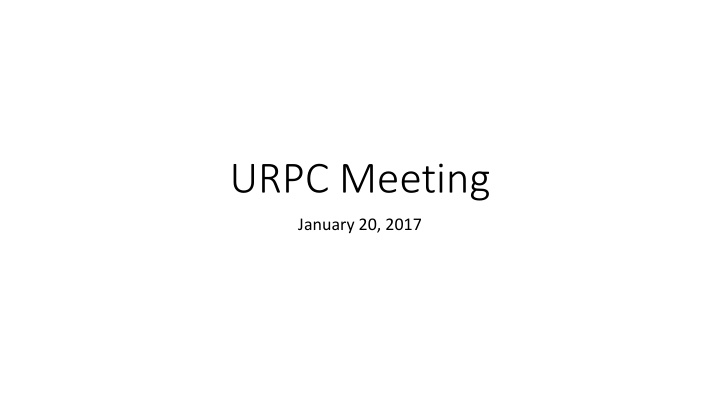



URPC Meeting January 20, 2017
URPC Agenda • Governor’s Budget • CSU Support Budget Request • Preliminary 2017-18 Budget • Spending Context • Enrollment • 5% Planning
Governor’s 2017-18 California Budget Proposal January 10, 2017 http://www.ebudget.ca.gov/budget/2017-18/#/BudgetSummary Note: Slides are from the Budget Proposal Summary
Governor’s 2017-18 CA Budget Proposal Governor emphasizing prudence • Volatile revenue – high reliance on income taxes • Recovery three years longer than average • High level of uncertainty regarding federal funding • Need to build reserves 2017-18 CA General Fund Budget: $122.5 billion (-.2%) • Without corrective action, deficit would be $1.6 billion • Proposing $3.2 billion in corrective actions
2017-18 CA Budget Increase for CSU New Allocations: +$161.2 million • $157.2 million General Fund increase (2% overall budget increase) • $5 million for capital outlay changes from debt shifting to CSU Does not fully fund CSU Support Budget Request
2017-18 CSU Support Budget Request to the State https://www2.calstate.edu/csu-system/about-the-csu/budget/2017-18-support- budget/Pages/default.aspx
CSU Support Budget Request
2017-18 Preliminary HSU Budget Planning
2017-18 HSU Operating Fund Budget Anticipated deficit between $3-$4 million • Close to $5 million including one-time funding and deficits in colleges Preliminary 2017-18 enrollment decrease of ~3% Still a lot of unknowns • State funding • Possible tuition increase • Enrollment • New compensation commitments – still in negotiations
Spending Context 2015-16 Spending per FTES Comparison to Similar Sized CSU Peers
2015-16 Spending per FTES (7,000 – 10,500 FTES CSU Campuses) $16,000 $15,810 $15,500 +$1,471/ $15,052 FTES $15,000 $14,878 $14,500 $14,339/FTES CSU 7-10.5k FTES average $14,000 (excluding HSU) $13,779 $13,648 $13,500 $13,000 $12,500 Bakersfield Humboldt San Marcos Sonoma Stanislaus
HSU would spend $________ LESS if our spending per FTES was the same as... Bakersfield Similar sized CSU peer ($13,648/FTES) average ($14,339/FTES) $11.7M $17.1M We spend 10% We spend 16% more per FTES more per FTES
2015-16 Spending Comparison by Functional Category (FIRMS/NACUBO Code) FUNCTIONAL CATEGORY HSU BAKERSFIELD DIFFERENCE % HIGHER Instruction 6,147 4,853 1,294 27% Research 46 64 (17) -27% Public Service 30 7 23 329% Academic Support 2,000 1,560 439 28% Student Support 1,658 1,742 (84) -5% Institutional Support 2,141 1,644 498 30% Op & Maint of Plant 2,032 1,799 233 13% Student Financial Aid 1,757 1,980 (223) -11% TOTAL SPENDING PER FTES 15,810 13,648 2,162 16%
Enrollment
Total Annual FTES Trends 8,000 7,923 7,733 7,800 7,560 FTES Enrollment 7,600 7,417 7,360 7,400 7,226 7,200 7,000 6,800
5% Planning
5% Planning Target • About 50% of the $11.7M 5% of 2016-17 base difference between our spending expenditure budget, excluding level and our CSU similar sized Financial Aid peers • Only 33% of the $17.1M difference between our spending and $5.7M Bakersfield • Even with the 5% reduction, our spending per FTES is still higher than our peers
5% Planning Approach: Focus on -5% • Two phased implementation approach • Phase 1: Initial implementation of options that can be implemented more quickly • Phase 2: Big picture redesign ideas with cross-divisional and/or broad University implications – will need extensive campus vetting prior to implementation • Note: Both phases should run in parallel
Phase 1 Ideas - Categories New Sources of Funding • Identify new revenue sources to support operations • Move existing expenses to alternate funding sources Budget Savings • Identify cost savings in existing operations Service Changes, Operational Redesigns, and Budget Reductions • Eliminate, reduce, or redesign services • Redesign existing operations to achieve savings Internal Reallocations • Reallocate savings to offset deficits or bolster high priority items
Pha hase e 1 Sum Summary: $ $2. 2.4 4 mill illio ion Service Budget Savings Changes, 40% Operational Redesigns, and Budget Reductions 44% New Sources of Funding (New Revenue or Funding Source Changes) 16%
Phase 1 se 1 Budget R t Reductio tions: $ : $1.0 m millio llion Breakdown by Strategic Asset Breakdown by Functional Category Category Brand Students Collections 4% 3% 6% Consumables Student 3% Support Academic 20% Support 31% Op & Maint of Plant Personnel Institutional 27% 84% Support 22%
URPC 5% Planning Discussion • Phase 1 options: provide feedback, develop communication plan • Are there any glaring omissions that should be considered? • Are there any major concerns with the proposed items? • Phase 2 recommendations: provide feedback on concepts, direction, and how to best engage the campus in this phase of the process
Recommend
More recommend